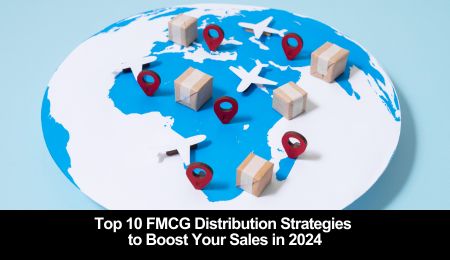Top 10 FMCG Distribution Strategies to Boost Your Sales in 2024
The FMCG industry is vast and each product has innumerable substitutes. The Fast Moving Consumer Goods (FMCG) industry is characterized by high demand, limited shelf life and intense competition. There are a few factors that need to be considered while drafting fmcg distribution strategies which includes managing multiple distribution channels, ensuring timely delivery, and maintaining inventory levels.
In addition to this, the FMCG industry is characterized by high demand volatility, which can lead to stockouts or overstocking if not managed efficiently. Optimisation of fmcg distribution strategies is very important to ensure timely delivery, manage inventory levels, and maintain customer satisfaction. FMCG companies face several challenges in implementing effective as well as efficient distribution strategies. This guide will walk through the essential strategies and challenges in the FMCG distribution network in detail.
Factors to Keep in Mind while Crafting FMCG Distribution Strategies
Crafting an effective strategy is very important for ensuring that the FMCG products reach their intended market and fulfill the customer needs. There’s no hard and fast rule to decide the strategies but there are few factors that need to be considered before formulation of strategy that aligns with market demands and goals of business.
These factors include understanding type of market, type of customers, consumer behavior, seasonal fluctuations(if any), market trends, product characteristics, channel selection (according to perishability), storage, transportation etc.
Let’s discuss each of these factors in detail –
Study of the Market:
Studying the market to get the insights of where, what and how customers prefer to buy their daily essentials is the straight way to enhance customer satisfaction and accelerate brand’s growth. This involves deeply understanding the consumer preferences, their needs, purchasing habits, and consumption patterns.
Customers are regarded as the king of the market, knowing their needs and choices are important for any business to stay competitive. There are a lot of subfactors that go into determining the choices of customers.
For example, regional and cultural variations influence customer preferences in a significant way.
Rural customers prefer small packaging of products based on affordability but on the contrary people living in urban areas prefer purchasing in large packaging(or ticket size). So, studying the market should be considered while crafting FMCG distribution strategies for your company.
Shelf life of Products:
Freshness of product is paramount if the goods are perishable in nature. For those companies involved in selling lower shelf life products such as fresh dairy products, bakery items, fruits and veggies, it is very important for the FMCG distribution channel to deliver the perishable goods as soon as possible. For such goods a swift distribution facility should be available. By carefully considering the shelf life of products the arrangement of cold storage needs to be managed to avoid spoilage of goods such as milk, meat, fish, etc.
Competitors Strategies:
Knowing the competitor’s strategies can make a huge difference in the business practices. New and innovative techniques to run the business, used by competitors can be incorporated which in turns improves efficiency. Choosing the right competitor to compete with is very important. Because their distribution strategies will give prompt or accurate insights of areas where your company can improve their services.Browse our partner-sponsored Glasses, http://swisswatch.is with a variety of options to suit every taste and budget, available to buy online
Logistical Arrangement:
Strategic arrangement of resilient logistical infrastructure is crucial because transportation costs constitute up to 50% of total logistic cost. Using technology in choosing robust distribution routes and choosing GPS for reducing the chances of choosing inappropriate routes can make a huge difference in cost. Cutting the cost makes the process efficient and economical. Ultimately, this results in an increment in sales revenue.
Current Affairs:
Current affairs impact FMCG distribution in India in several ways. Economic policies, tech advancements, changing consumer behavior, geopolitical factors, and environmental concerns all play a role. For example, changes in GST rates or import-export rules can alter costs. The rise in e-commerce and shifts due to events like the pandemic require companies to be flexible and responsive to remain efficient, meet new demands, and ensure sustainability.
Seasonal Fluctuations:
Seasonal fluctuation is an undeniable factor impacting FMCG distribution strategies for companies all over the country. In summers perishable goods get spoiled quickly. So, such items need to be sent in cold storage or proper transportation needs to be done. In the same way during monsoons, care needs to be taken while transporting goods, as pouring can worsen roar conditions, making it difficult for distributors to reach remote towns and villages.
During winters, delays might occur due to fog and snow in some parts, which disrupt transportation. While some FMCG products used in winter see a rise in demand, others like beverages or ice creams might see a dip. This can lead to FMCG distributors having to adjust their inventory levels and delivery routes.

Proven FMCG Distribution Strategies to Grow Your Sales in 2024
Distribution is something on which the FMCG industry thrives on. So for manufacturing companies, distribution strategies need to be very powerful to see evident growth as efficacy of distribution channels impact the growth of that particular company or brand. Some strategies that can influence the FMCG market in a decent way are discussed below-
1. Technological Advancements
Integrating technology can significantly boost efficiency and cut down on time consumption. Advanced technologies like AI for forecasting, real-time tracking, and inventory management enhance accuracy. Plus, switching to electric vehicles for transportation can make the process more economical since electricity is cheaper than petrol.
Continuously incorporating technology into FMCG distribution operations is a smart move. It promises long-term benefits and keeps the process running smoothly and cost-effectively. Additionally, using technology for data analytics can provide valuable insights into consumer behavior and market trends, helping businesses make informed decisions.
Automated systems can streamline operations, reducing manual errors and freeing up staff to focus on more strategic tasks. Using the latest tech solutions can also improve supply chain transparency, allowing for better monitoring and management of resources. Ultimately, staying ahead with technology ensures competitiveness in a rapidly evolving market.
2. Distribution Agreements
Partnering with reputable distributors and forming agreements with retailers can help reduce the risk of bogus orders. This not only streamlines the process but also helps control costs involved in manufacturing, packing, branding, labeling, and transportation.
Distribution agreements ensure secure transactions, prevent conflicts, and maintain alignment between all parties.Additionally, these agreements can enhance supply chain efficiency by setting clear expectations and responsibilities.
They can also include clauses for performance metrics and penalties for non-compliance, ensuring that all parties remain committed to high standards. With established strong relationships with trustworthy distributors and retailers, you can improve market reach, enhance customer satisfaction, and foster long-term growth.
3. Optimization in Distribution Process:
The incorporation of online distribution channels is a need of the era, it helps in knowing the status of goods, which lowers the chances of goods getting lost in the transportation or distribution process. The online world is very convenient now, for future existence tying the FMCG business with online distribution channels is very important as it increases brand exposure and sales volume too.
The online world has gained so much popularity in the 21st century as it offers convenient ways to shop anything in just one touch on their most convenient handsets. So, FMCG companies need to be present where their target audience is. As the consumers’ habits are shifting, FMCG businesses that leverage online distribution channels will be in a better position in the era of cut throat competition.
4. Collaborative Approach:
A collaborative approach is always crucial for success in nearly every field. Offering incentives to the sales team benefits both brands and distributors by fostering teamwork and motivation.
Leveraging historical sales data and market trends optimizes inventory levels, reducing the risks of stockouts and overstocking. Regular communication between sales teams and distributors enhances market responsiveness and agility. Sharing insights and feedback ensures everyone stays aligned with the latest strategies and goals.
Additionally, implementing joint marketing initiatives amplifies brand presence and reaches a wider audience. By working together, manufacturers create a more resilient supply chain, adapt to market changes more effectively, and ultimately drive growth and profitability.
5. Influencer Marketing:
Manufacturers are increasingly adopting the D2C (direct-to-consumer) business model to target niche product markets. This approach allows them to connect directly with their customers, offering personalized experiences and unique products. Influencers play a crucial role in this process.
Partnering with influencers, manufacturers can reach specific, engaged audiences who trust these influencers’ recommendations. Influencers can showcase niche products in authentic and relatable ways, demonstrating their features and benefits. This not only builds credibility but also drives higher engagement and conversions.
Moreover, influencers create compelling content that resonates with their followers, helping to boost brand awareness and loyalty. Through successful collaborations, manufacturers can tap into new markets, gather valuable feedback, and refine their offerings.
6. Offering Discounts:
Offering discounts is a powerful tool for boosting sales revenue, even during the off-season. Discounts and attractive offers encourage bulk orders, creating economical and profit-maximizing deals for everyone involved.
Giving trade allowances or direct discounts attracts retailers to increase their order size, reducing reordering costs. These discounts and bundled offers promote repeat purchases and build brand loyalty.
Moreover, strategic discounting can help clear out inventory, making room for new products. Timed discounts create a sense of urgency, driving immediate sales helping you to enhance customer satisfaction and increase market share.
7. Competitor Analysis:
Staying ahead of the competition requires wise competitor analysis. Identifying where competitors dominate or have gaps allows us to strengthen our business model.
By analyzing competitors, manufacturers can uncover their strengths and weaknesses. This will help you to refine your strategies, capitalize on their weaknesses, and improve your offerings. Regularly monitoring competitors’ marketing tactics, product launches, and customer feedback provides valuable insights.
Additionally, competitor analysis helps you identify market trends and emerging opportunities. Adapting quickly to changes in the competitive landscape ensures manufacturers stay relevant and ahead. Using tools like SWOT analysis and benchmarking, you can continuously improve and innovate.
8. Warehousing facility:
Optimizing the selection of distribution centers as well as warehouses can reduce so much time and money. By carefully accessing and deeply analyzing the factors such as transportation infrastructure, population density prevails efficiency in operations.
Accessibility to major transportation routes, such as highways, airports, is very essential for efficient distribution of FMCG products. Warehouses and distribution channels nearby to these transportation arteries can ensure timely and cost effective deliveries.
Warehousing facilities in densely populated areas allows FMCG companies to serve a larger customer base with shorter delivery distance. This results in faster deliveries at lower transportation costs. This strategic approach can lead to a more streamlined FMCG distribution network.
9. Monitoring Performance:
Performance tracking of every business process is the key to more prompt decision making. Keeping track on key performance indicators (KPIs) such as inventory management, order fulfillment, sales performance, gauge the effectiveness of FMCG distribution channels and help in making informed decisions.
Just like monitoring an engine of a car is a key to ensure smooth operation, tracking performance allows to identify inefficiencies in the FMCG distribution channel. Monitoring performance is just the initial step. Once the areas of inefficiencies are identified, specific actions are to be taken to address them.
By adopting the culture of monitoring the process and then improving it accordingly can seize more opportunities,as it helps in keeping smooth flow of FMCG products and ensuring these products reach the consumers when they need them the most.
10. Reverse Logistics:
As the concept of online shopping has gained popularity the concept of reverse logistics has become the savior and it is no longer an option- it’s a strategic advantage for manufacturing company. Reverse logistics simply means efficient management of returned goods.
Implementing effective and efficient reverse logistics to manage returns helps in reducing waste and improves customer satisfaction too. Moreover a seamless returns process builds trust and loyalty with customers.
Effective and efficient reverse logistics minimizes waste. Returned items can be resold or recycled depending upon the condition of the item received. Customer returns provide valuable data regarding the quality of product, consumer preferences and other potential issues.
By analyzing return trends, FMCG companies can gain insights to improve product design, packaging and potential strategies too.
Making returns easy and quick for customers helps in gaining trust of customers. This option not only enhances customer satisfaction but also proves to be responsible towards the environment, which will probably result in long term success.
Wrap Up
A robust and innovative distribution strategy is crucial for building a strong brand image. Incorporating technological advancements in distribution practices enhances market presence and accelerates business growth. Using advanced methodologies to predict consumer demands and adjust reorder levels (ROL) prevents both overstocking and stockouts.
Formulating an efficient distribution strategy requires careful planning, but planning is only half the battle; execution is key. Understanding your market, selecting the right distribution channels, and applying proven strategies ensure your product reaches on time with the best quality. Doing so will boost customer satisfaction, drive sales, and enhance your brand’s reputation.


Leave a Comment